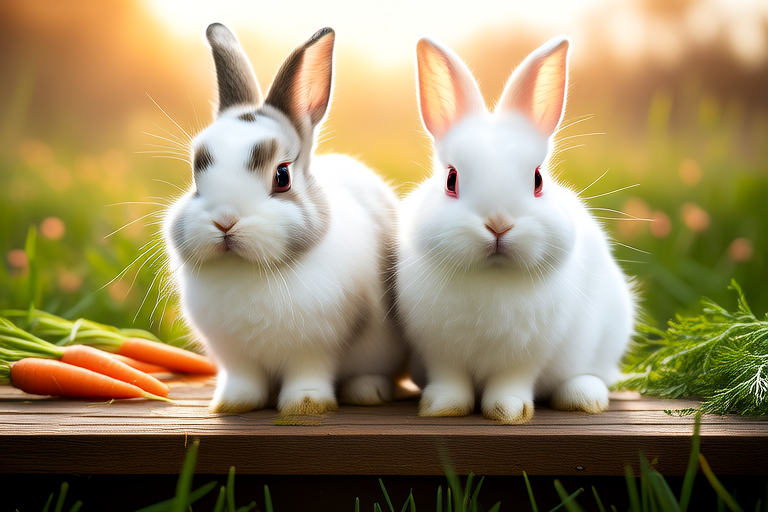Raising Hotot Rabbits: Tips for First-Time Owners from Experts
The Hotot rabbit, named after the town of Hotot-en-Auge in Normandy, France, is a breed that has captured the hearts of many rabbit enthusiasts. Originating in the early 20th century, the Hotot was developed by Eugenie Bernhard to create a rabbit with a striking black ring around its white eyes, resembling eye makeup. This unique feature makes them stand out among other rabbit breeds. Known for their docile and gentle nature, they are excellent pets for both experienced and novice rabbit owners.
Origins and Unique Features of Hotot Rabbits
The Hotot rabbit is a product of selective breeding, focusing on enhancing its distinct physical characteristics. The breed was initially created by Eugenie Bernhard, who aimed to develop a rabbit with a pure white coat and black eye rings. These rabbits have a compact body, short ears, and a smooth, dense fur. Their most notable feature is the complete black eye ring that encircles each eye, giving them a distinctive appearance.
Essential Care Tips for Hotot Rabbits
Diet
Proper nutrition is crucial for maintaining the health and vitality of your Hotot rabbit. A balanced diet should primarily consist of hay, which aids in digestion and dental health. Fresh vegetables and fruits can be offered as treats but should not exceed 10% of their daily intake. High-quality pellets should also be provided to ensure they receive necessary nutrients. Avoid feeding them sugary or starchy foods, as these can lead to obesity and dental issues.
Housing
Adequate shelter is essential for your Hotot rabbit’s well-being. They require a spacious hutch or cage that allows for plenty of movement and provides protection from the elements. Ensure the living space is clean and dry, with bedding made of straw or shredded paper. Ventilation is key; it should prevent the buildup of ammonia from urine. Place the hutch in a shaded area to protect them from extreme temperatures, as Hotots are sensitive to heat.
Grooming
Regular grooming helps maintain the rabbit’s coat and skin health. Use a soft brush to remove loose hair during shedding seasons. Bathing should be minimal, as rabbits are generally clean animals and prefer to groom themselves. Pay special attention to their eyes, keeping them free of discharge or debris that could obstruct vision. Trimming nails regularly prevents overgrowth, which can cause discomfort.
Health Checks
Regular health checks are vital for early detection of potential issues. Monitor their eating habits, droppings, and general behavior. Look for signs of illness such as lethargy, loss of appetite, or abnormal droppings. Consult a veterinarian if you notice any concerning symptoms. Vaccinations against common diseases like myxomatosis and viral hemorrhagic disease (VHD) are recommended based on geographical location.
Breeding Specifics
If you’re interested in breeding Hotot rabbits, there are several factors to consider. Select healthy adults with desirable traits for breeding. Ensure they are at least six months old and have reached sexual maturity. Breeding seasonally aligns with natural cycles, improving the chances of successful reproduction. Gestation lasts approximately 31 days, after which the doe will give birth to a litter of up to six kits. Newborns are born blind and hairless, requiring warmth and nourishment from the mother.
Socializing and Training
Socializing your Hotot rabbit from an early age helps build a trusting relationship. Spend time interacting with them daily, offering treats and gentle handling. This fosters trust and encourages positive behavior. Training can include basic commands like coming when called or sitting still for grooming. Positive reinforcement methods, such as rewarding good behavior with treats, work best. Patience and consistency are key to effective training.
Common Pitfalls and How to Avoid Them
Raising Hotot rabbits comes with its challenges, but being aware of common pitfalls can help prevent issues. One common mistake is providing insufficient space, leading to stress and behavioral problems. Ensure ample room for exercise and play. Another issue is improper diet, causing health complications. Stick to a balanced diet rich in hay, fresh vegetables, and high-quality pellets. Overlooking regular health checks can delay treatment for underlying conditions. Schedule routine visits to a veterinarian for preventive care. Lastly, inadequate socialization may result in fearful or aggressive behavior. Early and consistent interaction promotes a friendly and well-adjusted pet.
In conclusion, raising Hotot rabbits offers a rewarding experience for those willing to provide proper care and attention. By understanding their origins, unique features, and specific needs, first-time owners can enjoy a fulfilling bond with these charming creatures. With expert guidance and commitment, you can ensure a happy and healthy life for your Hotot rabbit.
